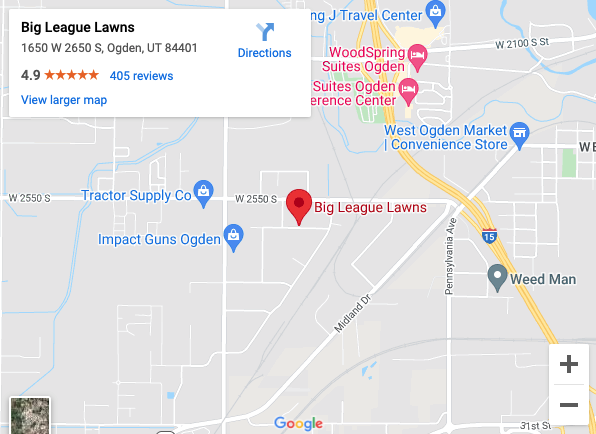Welcome to the Big League Lawns Help Center!
Here you will find answers to common lawn care questions. Everything from “How much should I water” to what to expect after you’ve had a treatment can be found below! If your questions can’t be answered here, or you’d just rather talk to us live, feel free to call!Questions and Answers About Weeds
No. Different weeds emerge at different times of the year; therefore, more than one weed control application is necessary depending on the season.
Because Dandelions are a broadleaf perennial; they cannot be prevented. Therefore they can only be controlled when they are actively growing. As a result, even the best cared for lawns will have an occasional dandelion.
There are two different types of herbicides: Selective and NonSelective.
Weed controls used for things like dandelions are “selective.” This means they kill Broadleaf plants but don’t kill Narrow leaf plants. As a result, they do not damage most grass types, thereby protecting your lawn. Unfortunately, this means things like Crabgrass and Tall Fescue, amongst other grasses, are also left unharmed.
In order to get rid of narrow leaf plants types, Non-Selective herbicides have to be used. Which means they will also damage your existing turf at the same time. This is why they are not used by most companies.
Weed controls used for things like dandelions are “selective.” This means they kill Broadleaf plants but don’t kill Narrow leaf plants. As a result, they do not damage most grass types, thereby protecting your lawn. Unfortunately, this means things like Crabgrass and Tall Fescue, amongst other grasses, are also left unharmed.
In order to get rid of narrow leaf plants types, Non-Selective herbicides have to be used. Which means they will also damage your existing turf at the same time. This is why they are not used by most companies.
Mowing Questions and Answers
Mow often enough to avoid removing more than 1/3 of the total blade length in a single mowing. Raise the mower height to 2 ½ – 3″ to improve the lawn quality and water retention.
Cool Season Grasses • Kentucky Bluegrass 2.5 to 3 inches • Perennial Ryegrass 2.5 to 3 inches • Tall Fescue 2.5 to 4 inches
Keep your mower blade sharp. A dull blade will tear the grass tips and give the lawn a brown cast.
Cool Season Grasses • Kentucky Bluegrass 2.5 to 3 inches • Perennial Ryegrass 2.5 to 3 inches • Tall Fescue 2.5 to 4 inches
Keep your mower blade sharp. A dull blade will tear the grass tips and give the lawn a brown cast.
Watering Questions and Answers
Early morning is the preferred time to water your lawn. Your lawn will have the opportunity to absorb the water before the sun heats and the water is lost to evaporation.
You never want to water at night, the turf could become more susceptible to diseases.
You never want to water at night, the turf could become more susceptible to diseases.
Watering is the most important thing you can do to impact the results we have on your lawn.
General Questions and Answers
10 to 14 days after a treatment your lawn should be greener and weeds should begin to twist and curl. However, this does not mean that they will disappear or be nonexistent from your lawn.
Difficult to control weeds like Oxalis may take several treatments. Of course, weeds also need time to dry out and break down before they dissipate. Because of this, twisting and curling are the appropriate signs that weed controls are working within 10-14 days after we visit.
If you ever have a question or concern regarding your lawn, feel free to call and we’ll be happy to take care of you.
Difficult to control weeds like Oxalis may take several treatments. Of course, weeds also need time to dry out and break down before they dissipate. Because of this, twisting and curling are the appropriate signs that weed controls are working within 10-14 days after we visit.
If you ever have a question or concern regarding your lawn, feel free to call and we’ll be happy to take care of you.
No. We will leave details about the application we applied, tips on what you can do to help, and post a sign in your yard.
We recommend that you have this done each year, preferably in the fall time. Most people don’t realize the fall is the best time to aerate. This is because your roots are growing in the fall more than any other time of year.
Think about how hard the ground is coming out of the hot summer months. Soils are hard and compacted. Root systems are weakened from drought stress. For them to recover and rebuild before next spring they need air, water, and fertilizer!
Aeration reduces soil compaction by removing thousands of soil plugs. As a result, oxygen, water, and nutrients can flow easily to the root zone. Thereby stimulating root development for a thicker lawn.
Call (801) 773-9999 to schedule an aeration call today!
Think about how hard the ground is coming out of the hot summer months. Soils are hard and compacted. Root systems are weakened from drought stress. For them to recover and rebuild before next spring they need air, water, and fertilizer!
Aeration reduces soil compaction by removing thousands of soil plugs. As a result, oxygen, water, and nutrients can flow easily to the root zone. Thereby stimulating root development for a thicker lawn.
Call (801) 773-9999 to schedule an aeration call today!
If you have thin turf, or your lawn has experienced summer damage and drought stress, we recommend reseeding along with your core aeration in mid-August to October.
We come out to your property every 4-6 weeks. This gives us the opportunity to stay on top of new weeds. This schedule also allows us to deliver the proper amount of fertilizer your turf needs to be healthy and consistently green.
A technician will be at your property anywhere from 10 to 20 minutes on average. Some of that is application time, load & unload time as well as administrative time.
Our commercial grade lawn care equipment is calibrated to deliver the proper amount of fertilizer and weed control to your lawn based on the lawns square footage.
Your technician is trained to walk at a specific pace for the equipment to deliver the proper amount of product per 1,000 square feet of turf. Walking too slow will deliver too much product to the turf and could result in burning the lawn.
When we are finished we’ll also take the time to leave notes and suggestions that will benefit your lawn.
Our commercial grade lawn care equipment is calibrated to deliver the proper amount of fertilizer and weed control to your lawn based on the lawns square footage.
Your technician is trained to walk at a specific pace for the equipment to deliver the proper amount of product per 1,000 square feet of turf. Walking too slow will deliver too much product to the turf and could result in burning the lawn.
When we are finished we’ll also take the time to leave notes and suggestions that will benefit your lawn.
The products need water to activate them, so as long as it wasn’t a lot of rain it will be beneficial to the turf. If the forecast is calling for a lot of rain our technicians will not treat the lawn. Like your normal watering schedule, rain can be good. However pouring rain all day is not.
We will begin applying the preventative grub control in late May through mid-August. This is the optimum time to get the best results from the treatment.
Pest Control / Bug Barriers Questions and Answers
Bug Barriers are a great way to keep insects out. Many things can impact the longevity of the application. Constant sunlight, watering, and foot traffic is just a few things that contribute to the breaking down of the barrier.
Typically a barrier will see a residual of up to 28 days. The trick is managing insect populations to levels that aren’t a nuisance. As a result, we recommend coming out after 4 weeks for best results.
Typically a barrier will see a residual of up to 28 days. The trick is managing insect populations to levels that aren’t a nuisance. As a result, we recommend coming out after 4 weeks for best results.


